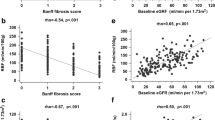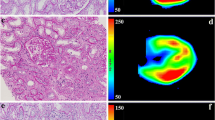Abstract
Purpose
This study aimed to explore the feasibility of susceptibility-weighted imaging (SWI) for evaluating delayed graft function (DGF) during the early posttransplantation period.
Methods
Sixty-nine recipients who accepted allograft renal transplantation underwent SWI during the second posttransplantation week. Renal allograft function was estimated via the glomerular filtration rate. Recipients with and without DGF were identified. For each transplanted kidney, the presence of abnormal signal intensity lesions (ASILs), excluding benign lesions, on SWI was assessed. Renal allograft function was compared between the recipients with and without ASILs. The correlation between ASILs and renal allograft function was tested by Spearman’s rank correlation analysis.
Results
Thirty-four recipients were diagnosed with DGF, while 35 recipients showed no DGF. In the DGF group, 16 recipients had low-intensity ASILs, primarily at the corticomedullary junction of transplanted kidneys on SWI, and no ASILs were found in 18 recipients. In the non-DGF group, none of the recipients showed ASILs on SWI. In the DGF group, the renal allograft function among the 16 recipients with low-intensity ASILs was significantly lower than that among the other 18 recipients (8.5 ± 4.2 vs. 19.7 ± 9.7 mL/min, P < 0.001). The presence of low-intensity ASILs on SWI showed a moderate negative correlation with renal allograft function in recipients with DGF (r = − 0.553, P = 0.001).
Conclusion
SWI can be used to evaluate DGF in the early post-kidney transplantation period.




Similar content being viewed by others
References
Hueper K, Khalifa AA, Brasen JH, et al. (2016) Diffusion-weighted imaging and diffusion tensor imaging detect delayed graft function and correlate with allograft fibrosis in patients early after kidney transplantation. J Magn Reson Imaging 44:112–121
Fonseca I, Teixeira L, Malheiro J, et al. (2015) The effect of delayed graft function on graft and patient survival in kidney transplantation: an approach using competing events analysis. Transpl Int 28:738–750
Gill J, Dong J, Rose C, et al. (2016) The risk of allograft failure and the survival benefit of kidney transplantation are complicated by delayed graft function. Kidney Int 89:1331–1336
Malyszko J, Lukaszyk E, Glowinska I, et al. (2015) Biomarkers of delayed graft function as a form of acute kidney injury in kidney transplantation. Sci Rep 5:11684
Thoeny HC, Zumstein D, Simon-Zoula S, et al. (2006) Functional evaluation of transplanted kidneys with diffusion-weighted and BOLD MR imaging: initial experience. Radiology 241:812–821
Sadowski EA, Fain SB, Alford SK, et al. (2005) Assessment of acute renal transplant rejection with blood oxygen level-dependent MR imaging: initial experience. Radiology 236:911–919
Haacke EM, Xu Y, Cheng YC, et al. (2004) Susceptibility weighted imaging (SWI). Magnetic resonance in medicine. Magn Reson Med 52:612–618
Li C, Ai B, Li Y, et al. (2010) Susceptibility-weighted imaging in grading brain astrocytomas. Eur J Radiol 75:e81–e85
Dai Y, Zeng M, Li R, et al. (2011) Improving detection of siderotic nodules in cirrhotic liver with a multi-breath-hold susceptibility-weighted imaging technique. J Magn Reson Imaging 34:318–325
Xing W, He X, Kassir MA, et al. (2013) Evaluating hemorrhage in renal cell carcinoma using susceptibility weighted imaging. PLoS One 8:e57691
Balassy C, Feier D, Peck-Radosavljevic M, et al. (2014) Susceptibility-weighted MR imaging in the grading of liver fibrosis: a feasibility study. Radiology 270:149–158
Inker LA, Schmid CH, Tighiouart H, et al. (2012) Estimating glomerular filtration rate from serum creatinine and cystatin C. N Engl J Med 367:20–29
Saat TC, van den Akker EK, IJzermans JN, et al. (2016) Improving the outcome of kidney transplantation by ameliorating renal ischemia reperfusion injury: lost in translation? J Transl Med 14:20
Santos J, Martins LS (2015) Estimating glomerular filtration rate in kidney transplantation: Still searching for the best marker. World J Nephrol 4:345–353
Miglinas M, Supranaviciene L, Mateikaite K, et al. (2013) Delayed graft function: risk factors and the effects of early function and graft survival. Transplant Proc 45:1363–1367
Hall IE, Koyner JL, Doshi MD, et al. (2011) Urine cystatin C as a biomarker of proximal tubular function immediately after kidney transplantation. Am J Nephrol 33:407–413
Zheng X, Zang G, Jiang J, et al. (2016) Attenuating Ischemia-Reperfusion Injury in Kidney Transplantation by Perfusing Donor Organs With siRNA Cocktail Solution. Transplantation 100:743–752
Jang HR, Ko GJ, Wasowska BA, et al. (2009) The interaction between ischemia-reperfusion and immune responses in the kidney. J Mol Med (Berl) 87:859–864
Mie MB, Nissen JC, Zollner FG, et al. (2010) Susceptibility weighted imaging (SWI) of the kidney at 3T–initial results. Z Med Phys 20:143–150
Ding J, Xing W, Wu D, et al. (2015) Evaluation of Renal Oxygenation Level Changes after Water Loading Using Susceptibility-Weighted Imaging and T2* Mapping. Korean J Radiol 16:827–834
Welch WJ (2006) Intrarenal oxygen and hypertension. Clin Exp Pharmacol Physiol 33:1002–1005
Zhang W, Edwards A (2002) Oxygen transport across vasa recta in the renal medulla. Am J Physiol Heart Circ Physiol 283:H1042–H1055
Author information
Authors and Affiliations
Corresponding author
Ethics declarations
Funding
This work was supported by the National Natural Science Foundation of China (Grant Numbers 81771798), and major scientific and technological projects of the Changzhou Municipal Commission of Health and Family Planning (Grant Numbers ZD201509).
Conflict of interest
All authors declare that they have no conflicts of interest.
Ethical approval
All research procedures were conducted in accordance with the Declaration of Helsinki. The local ethics committee approved this retrospective study.
Informed consent
Informed consent was obtained from all participants included in the study.
Rights and permissions
About this article
Cite this article
Sun, J., Yu, S., Chen, J. et al. Assessment of delayed graft function using susceptibility-weighted imaging in the early period after kidney transplantation: a feasibility study. Abdom Radiol 44, 218–226 (2019). https://doi.org/10.1007/s00261-018-1709-7
Published:
Issue Date:
DOI: https://doi.org/10.1007/s00261-018-1709-7




